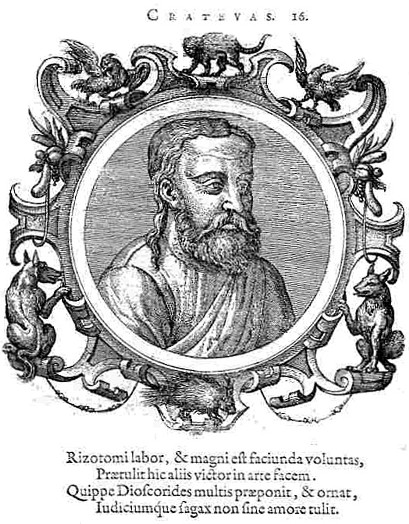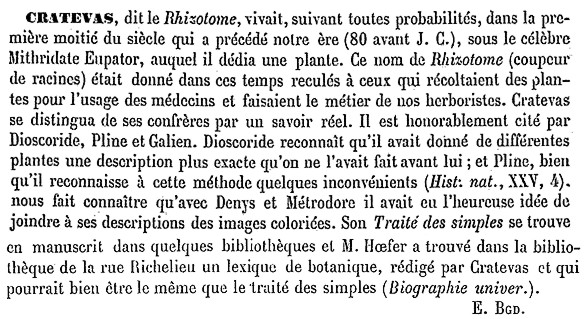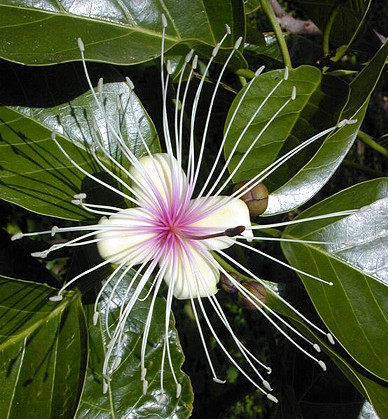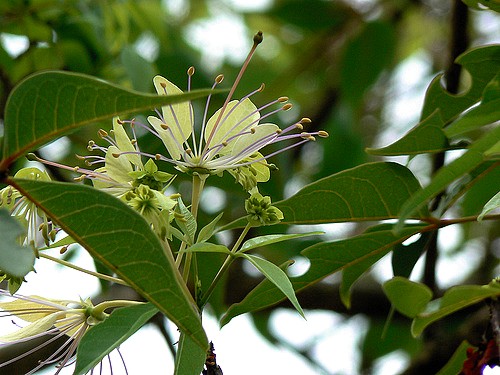Lessico
Crateva

Icones
veterum aliquot ac recentium Medicorum Philosophorumque
Ioannes Sambucus / János Zsámboky![]()
Antverpiae 1574
Crateva - Krateúas
in greco - visse intorno all'80 aC e veniva detto il Rizotomo, il tagliatore
di radici, appellativo riservato a coloro che raccoglievano piante a uso
medicinale ed esercitavano una professione equivalente a quella dei nostri
erboristi. Viene citato da Diorcoride![]() nella
prefazione al suo trattato De materia medica
nella
prefazione al suo trattato De materia medica![]() : "Cratevas
autem herbarius, et Andreas medicus, qui caeteris diligentius hac in parte
versati videntur, radices multas apprime utiles, herbasque aliquas haud
quaquam adnotatas reliquerunt." Viene citato anche in I,27 a proposito
dell'helénion egiziano
: "Cratevas
autem herbarius, et Andreas medicus, qui caeteris diligentius hac in parte
versati videntur, radices multas apprime utiles, herbasque aliquas haud
quaquam adnotatas reliquerunt." Viene citato anche in I,27 a proposito
dell'helénion egiziano![]() (Alterum Helenii genus in Aegypto gigni Cratevas tradit) e in I,103 a
proposito dell'halimus (Tertium quoque genus addidit Cratevas sub
hedera tantum nasci, longioribus foliis, hirsutioribusque odore cupressi).
(Alterum Helenii genus in Aegypto gigni Cratevas tradit) e in I,103 a
proposito dell'halimus (Tertium quoque genus addidit Cratevas sub
hedera tantum nasci, longioribus foliis, hirsutioribusque odore cupressi).
Crateva
non mancò di essere citato sia da Plinio![]() (XXV,8)
che da Galeno
(XXV,8)
che da Galeno![]() . Fu
medico di Mitridate VI Eupatore re del Ponto detto il Grande
. Fu
medico di Mitridate VI Eupatore re del Ponto detto il Grande![]() (ca. 132-
63 aC), colui che diede il nome al mitridatismo
(ca. 132-
63 aC), colui che diede il nome al mitridatismo![]() , cioè
all’assuefazione ai veleni, e aveva realizzato un erbario figurato per conto
del suo re. Tale erbario nel tempo si è disperso, ma una copia pare sia
servita a preparare, alla corte di Bisanzio agli inizi del VI secolo dC, un
erbario di fattura molto raffinata più noto come Codex Aniciae Iulianae.
Linneo gli dedicò il genere Crateva
, cioè
all’assuefazione ai veleni, e aveva realizzato un erbario figurato per conto
del suo re. Tale erbario nel tempo si è disperso, ma una copia pare sia
servita a preparare, alla corte di Bisanzio agli inizi del VI secolo dC, un
erbario di fattura molto raffinata più noto come Codex Aniciae Iulianae.
Linneo gli dedicò il genere Crateva![]() della famiglia Capparaceae, alla quale appartiene, per esempio, il
cappero
della famiglia Capparaceae, alla quale appartiene, per esempio, il
cappero![]() , Capparis
spinosa.
, Capparis
spinosa.
He was physician in ordinary to Mithridates VI Eupator, King of Pontus (died 63 BC). Krateuas described as well as illustrated plants. Some fragments of his writings have been recognized in the Anicia Codex of Dioscorides in the Vienna State Library to which reference has been made above. Krateuas presumably produced the figures in natural color and they were continuously copied in many manuscripts and printed herbals from the 6th Century on. Krateuas is mentioned by Pliny in XXV,8:
Praeter hos Graeci auctores prodidere, quos suis locis diximus, ex his Crateuas, Dionysius, Metrodorus ratione blandissima, sed qua nihil paene aliud quam difficultas rei intellegatur. Pinxere namque effigies herbarum atque ita subscripsere effectus. Verum et pictura fallax est coloribus tam numerosis, praesertim in aemulationem naturae, multumque degenerat transcribentium socordia. Praeterea parum est singulas earum aetates pingi, cum quadripertitis varietatibus anni faciem mutent.
"Krateuas, Dionysios and Metrodoros adapted a most attractive method, though one which makes clear little else except the difficulty of employing it. For they painted likenesses of the plants and then wrote under them their properties. But not only is a picture misleading when the colors are so many, particularly as the aim is to copy nature, but besides this, much imperfection arises from the manifold hazards in the accuracy of copyists. In addition, it is not enough for each plant to be painted at one period only of its life, since it alters its appearance with the fourfold changes of the year." - Pliny, Natural History (XXV.8)
www.osu.edu
Crateuas
Court physician to Mithridates VI, king of Pontus (120-63 BC), Crateuas was a rhizotomist (root cutter or herb gatherer), whose own illustrated herbal, the oldest treatise on pharmacology and the first to be illustrated, has been lost. Dioscorides speaks respectfully of him in his preface, although commenting that he did omit "many exceptionally useful roots and a few herbs." Singer contends that eleven illustrations in the Codex Vindobonensis, beginning with the one above, which are especially well drawn and include quotations from Crateuas, may have been copied from the earlier work.
Riddle argues, however, that both Crateuas and Dioscorides originally were written on papyrus scrolls. Their drawings would have been in ink wash; otherwise, the paint would have cracked and flaked off as the scroll was rolled and unrolled. The paintings on parchment in the Vienna Discorides seem to him to be too finely detailed to have been copied from such crude originals (indeed, Pliny is dismissive of their accuracy). That De Materia Medica, itself, originally was illustrated can be assumed from the text, which very often does not describe the plant but only its medicinal uses. An accompanying illustration often would have been required if the text was to make sense.
http://penelope.uchicago.edu
Dictionnaire
encyclopédique
des sciences médicales
1864-1888

Krateuas, auch Kratevas, Crateuas oder Cratevas, genannt „der Wurzelschneider“ (griechisch Krateúas ho Rhizótomos), war ein griechischer Arzt und Pharmakologe um 100 v. Chr. Krateuas war Leibarzt von Mithridates VI. von Pontos. Er verfasste ein dreiteiliges Kräuterbuch in dem er die medizinischen Eigenschaften von Pflanzen beschrieb. Eine zweite, volkstümliche Ausgabe versah er mit farbigen Abbildungen und ordnete die Pflanzen alphabetisch an. Damit schuf er das erste mit Pflanzenabbildungen versehene Kräuterbuch, das zum Vorbild für zahlreiche Nachfolger wurde. Es sind bisher lediglich zwei Papyrusfragmente bekannt. Plinius der Ältere berichtet, dass Krateuas Bilder von Pflanzen gemalt und darunter deren Wirkung verzeichnet habe.
Krateuas’ Buch gilt als eine der Hauptquellen für Dioscurides. Bei einigen der Tafeln des sogenannten „Wiener Dioskurides“ wird die Abbildung durch einen kurzen Text ergänzt, der mit dem Namen Krateuas beginnt. Ein Bild von Krateuas befindet sich auf Tafel 3 des „Wiener Dioskurides“.
Im 16. Jahrhundert soll sich in Konstantinopel noch eine Sammlung von Illustrationen von Krateuas befunden haben. Carl von Linné benannte Krateuas zu Ehren die Gattung Crateva der Pflanzenfamilie der Kaperngewächse (Capparaceae).
Crateva
religiosa
syn
Crateva adansonii

Nine species are found in tropical regions excluding Australia and New Caledonia. Much of the literature refers to Crataeva rather than Crateva species. However, the latter is considered to be the correct form since the genus was named after the Greek herbalist Kratevas who was renowned for his skill in poisoning.
The flowering tree Crateva religiosa (syn Crataeva religiosa, Crateva adansonii) is called the sacred garlic pear and temple plant, and many other names in a variety of dialects, including abiyuch, barna, varuna, and bidasi. The tree is sometimes called the spider tree because the showy flowers bear long, spidery stamens. It is native to Japan, Australia, much of Southeast Asia and several south Pacific islands. It is grown elsewhere for fruit, especially in parts of the African continent.
The fruit of the tree is edible. The nectar-filled flowers are attractive to a multitude of insects and birds. The pierid butterfly (Hebomoia glaucippe) is a frequent visitor to this plant.
